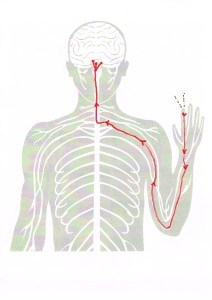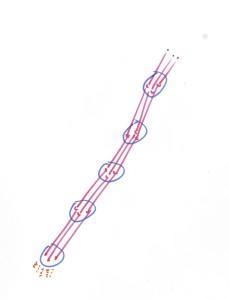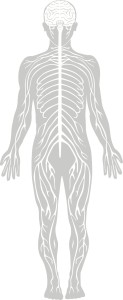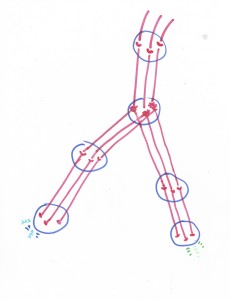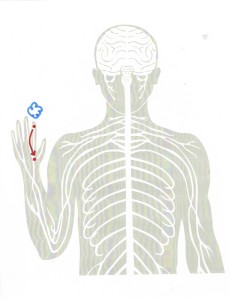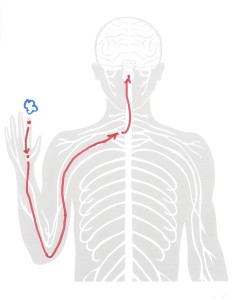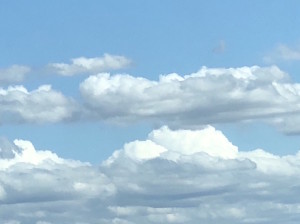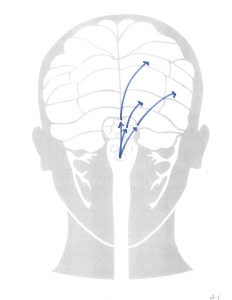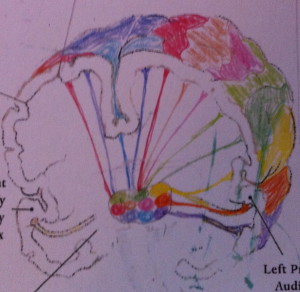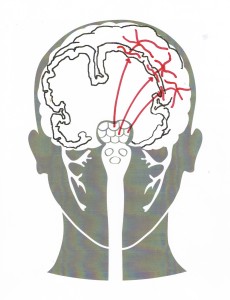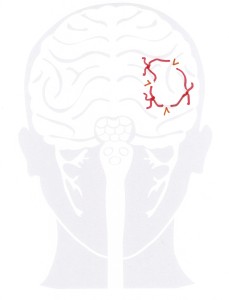a theory: the impulsing model
general structure of the nervous system
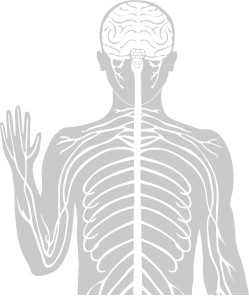
**
structure of inner circuitry
4 linked areas = 4 kinds of conscious work
from sensory neuron groups … to thalamus … sensation
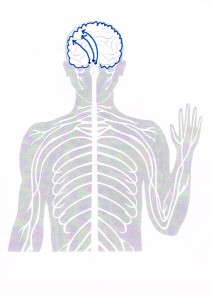
from thalamus … to cortex …record-making … recognition
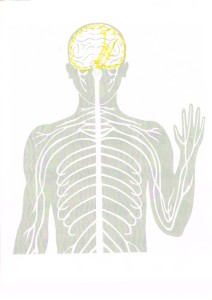
from cortex … to thalamus …thought
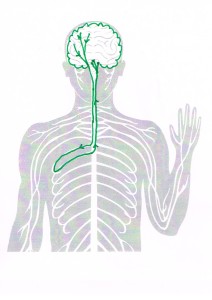
from cortex … to muscle landscape … to thalamus … forming & releasing tension patterns = feelings
**
**
conscious stream …
a series or stream of conscious instants
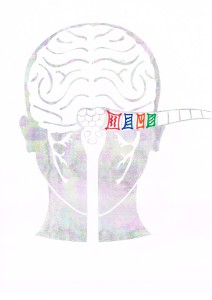
**
How the nervous system works … in 2 parts
Part 1 – tracing energy: impulsing
Part 2 – applying impulsing: to 4 areas of conscious pathways
…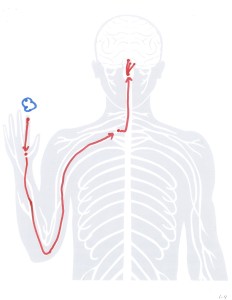



…
**
PART 1 • PART 1 • PART 1
tracing energy in the nervous system
… in the form of an impulse trail … impulsing
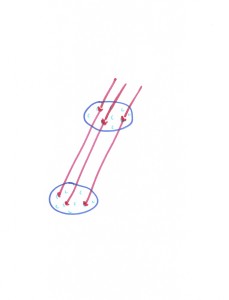
• absorbing and propelling energy
as sensory groups/assemblies in the body’s periphery are exposed to … energies in the body and the environment … they are monitoring … the form of energy they’re designed to
**
• converging energy
incoming trails into same group are resolved when converging energy reinforces their common pattern … propelling a stronger trail … further into the circuitry
…
**
consider this …
the absorption (monitoring) & convergence (resolving) of energy in the nervous system … infers the system’s primary work is to monitor and resolve
…
…
**
following an impulse trail … in the conscious pathway
sensory assemblies absorb energy … in the body and environment … and form a series of energized groups … to the thalamus
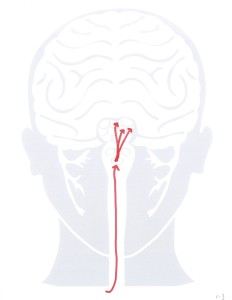
as an impulse trail reaches the thalamus … it splits to simultaneously energize a set of the thalamus groups: these groups represent the potential qualities of an instant of consciousness
…
**
there are 2 kinds of qualities that makeup an instant of consciousness:
• some sense-specific qualities of vision: blue, white & edges of clouds
• some inter-sensory qualities of vision: softness, lightness
…
**

• as a trail passes & energizes the thalamus … it adds a single instant of consciousness into an evolving conscious stream
and
• like frames on a reel of film … instants of consciousness blur together … to form the seamless experience … in us ... we call … consciousness
#
…
**
PART 2 • PART 2 • PART 2
applying impulsing… to the conscious pathways
…
**
conscious work in Area 1:
experiencing sensation
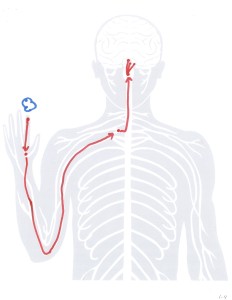
when a trail from a sensory assembly generates a series of energized neuron groups … that reaches the thalamus, the trail’s impulses split to energize a set of its groups
this series of energized neuron groups is formed so quickly, lightening-like, we experience them simultaneously … as an instant of sensation … in us … as a part of us
we experience an instant of sensation … in the conscious stream
#
conscious work in Area 2:
forming a record of each conscious instant:
experiencing recognition
…
**
a record: a pattern of fused neurons
• in the future, energy into any part of this record, energizes the entire record
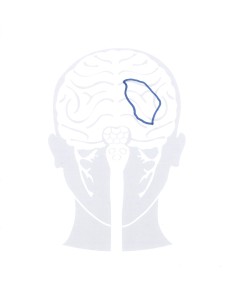
…
**
enlarged records: joining records at shared qualities …
chat / cat (sharp “t” sound) in word + cat’s sharp claws … or hiss sound
le chaton / kitten (soft “n” sound) in word + softness of kitten’s fur
Chinese word for cat: mao (word sound) + sound we hear cat makes
…
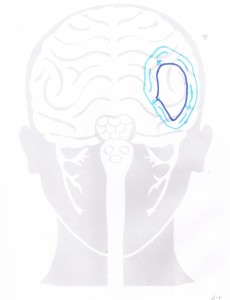
…
**
an incoming trail’s left-over energy
• after a record is made the trail’s residual energy sinks into … its adjacent related records: and we experience an instant of recognition … in the conscious stream
…
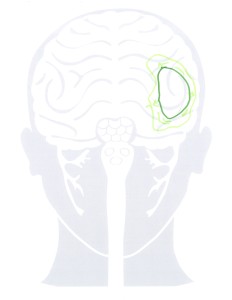
**
• a trail’s left-over energy can also reach further into the network … to energize its related records … records that have any of the same qualities in their makeup

#
**
Conscious work in Area 3:
deriving thought
resolving simultaneously energized areas of network:
…
the convergence of energized areas derives a resolution … a reinforced pattern
… that propels a trail to the thalamus
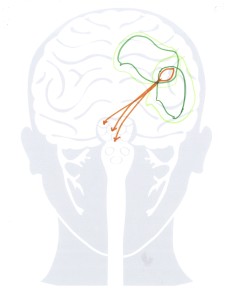
and we experience a thought … in the conscious stream
…
an example: when the word of the color orange (energizing related records) & image of sky (energizing related records) … the energized areas overlap to derive a trail to the thalamus: we may then experience the thought of … a sunset
#
**
Conscious work in Area 4:
generating & releasing feelings
resolving 2 kinds of energized areas in the network
• when this sensation reaches the thalamus … we experience a subtle reflective tension pattern in the muscle … a feeling … so a feeling enters … the conscious stream
…
**
• this tension pattern, stays energized … for as long as … the current sensation or thought is present … so …
• when the sensation or thought is no longer present, its reflective tension is released … and we experience this reversal of tension … as a kind of balance … we can call a balanced feeling … or emotional balance …
…• on the other hand, when the sensation or thought doesn’t change … the generation continues … and … the tension pattern’s intensity increases …
the added intensity gets our attention … to encourage deriving a resolution … that changes … and relieves the tension … providing a balanced feeling
*
• in this way, feelings reflect the fluency current monitoring & resolving work … in the conscious pathways
…
**
Using this theory

…
• knowing how a system functions includes knowing how it functions well
this study’s goal has been to learn how the nervous works at the lay level, so we can stay in sync … with good functioning …
consider this …
in the nervous system … working well … turns out to be … maintaining the fluent monitoring & resolving activity … that supports balanced feelings … while supporting social needs & environmental resources that support us!
…
**
a balanced lifestyle
• to support balanced activity … we can develop a balanced lifestyle: a personal pattern of balanced activities … that steadily maintains balanced feelings, while using & supporting personal, social & environmental resources
• a balanced lifestyle depends on exposures and resources available and as conditions change, it can be adjusted and tuned-up
• as each activity is completed, the state it leaves supports triggering the next activity; all together, to ensure ongoing balanced feelings, activities that resolve evolving needs are established
**
base activities of a healthy lifestyle
• a healthy lifestyle is based on a pattern of physiological activities
• on this base, we build in other personal activities based on our personal character: activities interest and exercise us!
• a balanced lifestyle also includes activities to help meet social needs & to restore the environmental resources we use, in turn
*
*
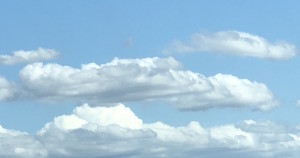
going forward
• together, by providing exposures and resources … we can help each other avoid out of balance states … and build in activities … to makeup healthy lifestyles … that overall … support personal, social & environmental integrity
…
Thank you!
and
let’s take care of each other!
**
**
for reference: impulsing.net
all rights reserved
